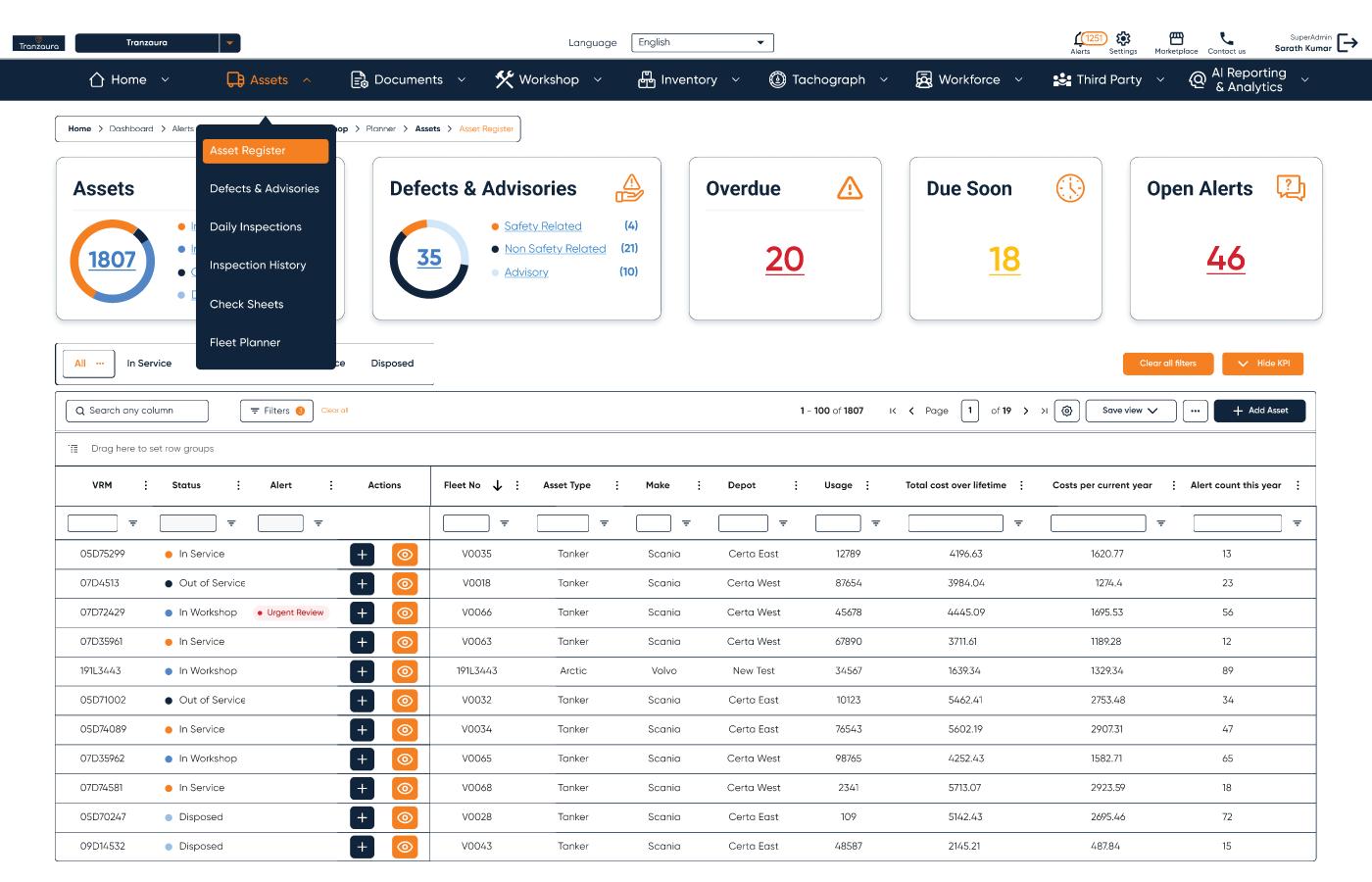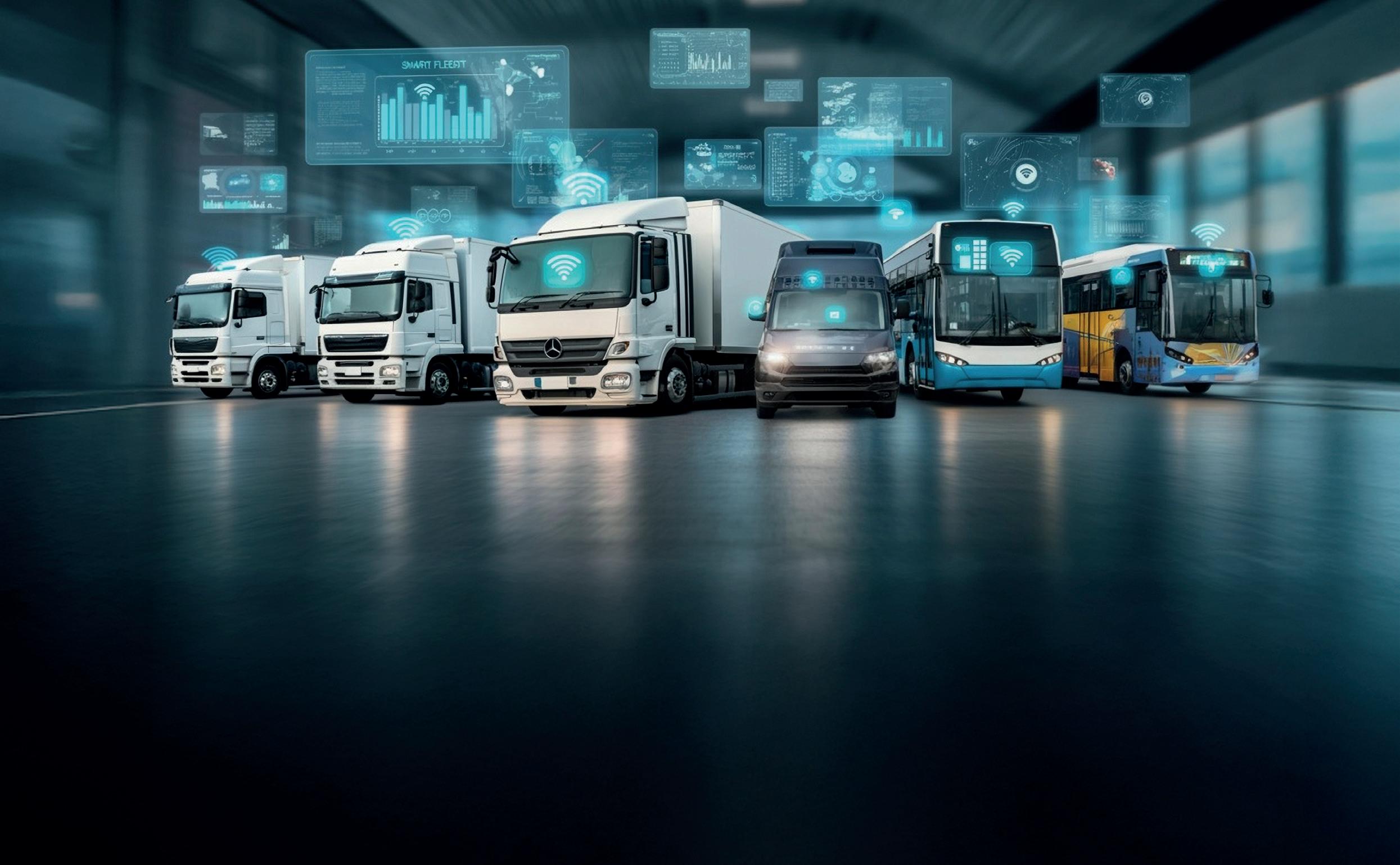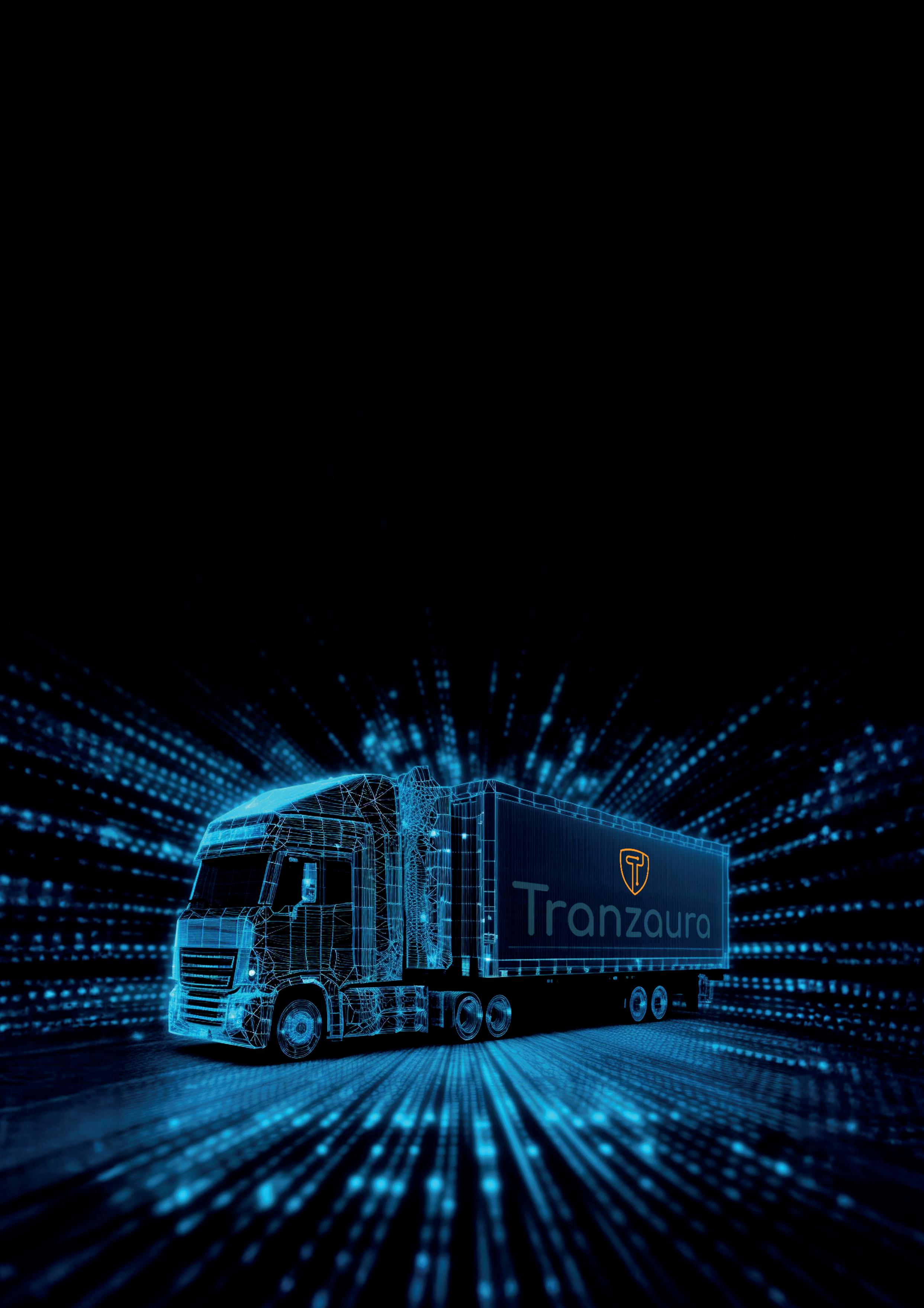




10 steps for using Artificial Intelligence to revolutionise fleet management

Enhancing fleet operations without disruptions
Reducing fuel costs through smarter routing
Powered by INCLUDING
Highlighting risky driving behaviours
Integrating multiple systems
Fixing data dilemmas






The FleetNow Platform is an all in one system to advance how you manage, monitor and maintain your fleet in real time. Take control of your time, your money and compliance.

Artificial intelligence is already reshaping the way fleet operators work, and the journey is only just beginning. At Tranzaura, we’ve always believed in putting people at the heart of fleet safety, compliance and performance, but that mission is now being supercharged by AI.
Our FleetNow platform helps to consolidate fleet data from multiple silos into one intelligent ecosystem. Using the latest AI capabilities, we can then empower fleet professionals to make better-informed decisions ten times faster than before.
The result is improved uptime, reduced costs, and safer teams. From driver performance insights and
efficiency monitoring to maintenance forecasting, we are using AI to deliver meaningful change in the way data is presented, and then used, by fleets.
Whether you’re starting to explore AI, or already leading the innovation, this whitepaper is a valuable resource for fleet professionals at every stage of the journey. You’ll find the inspiration and guidance to revolutionise your fleet, using the remarkable intelligence and insight provided by Tranzaura, and AI.

Emma Gill, Head of Marketing, Tranzaura
4 Step One: Understanding The data dilemma
5 Step Two: Integration Consolidation is the key
5 Step Three: Support Your intelligent co-pilot
6 Step Four: Motivation Benefits and experience
7 Step Five: Exploration Ask questions of AI
7 Step Six: Action A practical roadmap
8 Step Seven: Innovation Enhancing fleet operations
8 Step Eight: Culture Embedding AI into fleet
9 Step Nine: Enhancement What’s next for AI?
9 Step Ten: Empowerment Providing results

T he speed at which fleet management technology is progressing cannot be underestimated. Not long ago, the industry moved from manual data consolidation to web-based applications. Now, with the roll-out of AI, we have reached another turning point, which promises to make fleets more efficient and connected than ever before.
Fleets are generating more data than ever, yet many remain overwhelmed and under-informed, unable to reconcile fragmented systems, siloed data and the heavy admin burden.
As a result, fleet managers are prevented from accessing timely insights that could improve efficiency, compliance, and safety.
Drawing on insights from our recent AI webinar, online survey and fleet interviews, this whitepaper explores how AI is being deployed across UK fleets, outlines barriers to adoption, and presents actionable steps and tools for adoption.
The message is clear: AI is not a future concept, but a presentday strategic advantage. Fleets that embrace AI now stand to gain in efficiency, safety, sustainability, and competitiveness.
F
leets today are navigating a complex and fragmented data landscape. Often they have an abundance of legacy systems and data streams, and each one contributes information that needs to be collated, evaluated and acted upon.
Understanding this information is key to improving overall fleet performance and efficiency, but often the data is not meaningful at a surface level, or too vast in scale to create useful insights within a reasonable timescale.
Modern fleets rely on a range of technologies to monitor vehicles, drivers and compliance, including telematics, fuel cards and fleet management software.
It may be that each data stream on its own is great, but making sense of it together in one clear picture when viewed through a patchwork


Disconnected data leads to:
● Manual reporting and duplicated effort
● Unreliable data
● Lack of real-time visibility
● An inability to build trends
● Reactive, not proactive, fleet management
● Increased operational costs
Organising driver training
Charging vehicles
Organising hire vehicles
Unplanned vehicle downtime
Tracking and routing fleets
Paying and reporting for fuel
Organising servicing and maintenance
of disconnected systems, duplicated admin and fragmented formats is hugely challenging. The result is operational and strategic decisions which are delayed, or not made with complete confidence.
In our survey of fleet managers about their experience in this field, the top five operational pain points are related to the need for a robust dashboard of consolidated data to aid transparency and inform outcomes.
According to one industry leader, “data is only as valuable as your ability to act on it”.
Before AI can add value, fleet data needs to be consolidated. Cloud-based platforms and fleet management software increasingly offer this integrated capability, turning raw data into structured dashboards and alerts through seamless API data connection.
32%
Recent insights from the Fleet Outlook Report identified that 32% of fleets identified integration of supplier data as their biggest pain point.
W
hen we talk about AI in fleet management, we’re not referring to robots taking over. We’re talking about intelligent systems designed to enhance, not replace, human judgment.
AI simulates elements of human thinking, helping fleet managers make smarter, faster, and more informed decisions.
This could be by automatically generating safety reports about drivers and compliance alerts on vehicles, or spotting maintenance trends that inform servicing schedules.
AI can also be used to provide instant answers to day-to-day operational questions hidden within your data.
Benefits of integrated systems include:
● One single source of truth across siloed fleet data
● Real-time fleet intelligence with key metrics
● Automated reminders and alerts
● Visual dashboards to prioritise actions
This foundational step transforms a data deluge into an environment AI can work within.
According to the Fleet Outlook Survey of 100 UK fleet operators, AI is already finding a foothold in key operational areas. The top four use cases identified were:

● Highlighting risky or inefficient driving behaviours
● Anticipating maintenance needs before breakdowns occur
● Automatically generating safety reports and compliance alerts
● Providing instant answers to day-to-day operational questions
STEP I FOUR: MOTIVATION
If AI is the co-pilot, the road ahead is already being charted by those who’ve taken the first steps. As the fleet manager, you probably have intuition and experience about your drivers and vehicles, and an idea about what needs to be improved. But in order to engage stakeholders, you
need the facts and insight to effect positive change.
AI can be used in many areas including highlighting cost savings, identifying downtime issues, and helping to decarbonise a fleet.
By demonstrating that it can bring benefits, you can motivate the wider business to join in the journey.
82% of operators said cost savings were their primary motivation for exploring AI
82% 46% 91%
46% identified safety and compliance improvements as key drivers
91% expect their organisation’s investment in AI to grow over the next three years
These are not abstract benefits. They are operational, easier, faster, safer ways to run a fleet. And with the right strategy, they’re available to every fleet, regardless of size.
Fleets that have embraced AI report measurable improvements - not just in theory, but in real-world performance. Early adopters are seeing tangible gains in both cost and compliance, including:
● Reduced fuel consumption through smarter routing and optimisation
● Fewer incidents and collisions, thanks to data-driven driver coaching
● Less downtime, by predicting vehicle faults before they happen
STEP I FIVE: EXPLORATION

STEP I SIX: ACTION
T aking the first step with AI doesn’t require a major investment. It just requires intent. And for fleets willing to experiment, early, easy wins are well within reach.
Probably, you’re not going to set AI the challenge of planning a complete electrification of your fleet and infrastructure as the first task. Instead, use it to help with smaller projects that allow you to report on, and then action.


Despite the proven benefits, over half of UK fleets remain on the sidelines. The Fleet Outlook Survey found that 55% of fleet operators have no current plans to adopt AI.
But here’s the reality: AI isn’t going away. And early evidence suggests that now is the time to engage, however lightly, so that decisions are made with clarity, and not under pressure. Doing nothing means falling behind. It allows inefficiencies to persist, blindsides your operation to risk, and limits your future options.
The good news? You don’t need
to go all-in. Exploration, education and experimentation are the best starting points.
As one UK fleet manager noted: “We’re only scratching the surface, but the potential is enormous.”
There are concerns, not least in how to start using AI and what tools are suitable. That’s why embedded AI in fleet management systems such as FleetNow offers easy initial access to the AI world.
By simply testing - asking it questions and getting answersyou can explore your fleet using AI.
That way, you build knowledge and confidence, allowing you to act on what you discover.
The hesitation is understandable. Common concerns include:
● Uncertainty around return on investment
● Perceived complexity of AI tools, and where to start
● A lack of in-house expertise in using AI
● Fears around data privacy, disruption, or job security
The most successful adopters treat AI not as a standalone project, but as a tool embedded in everyday workflows. Even simple use cases can unlock real, measurable value:
● An up-to-date fleet policy that reflects current legislation - created in minutes using tools like ChatGPT
● Improved driver engagement and safety through automated video briefings generated with Synthesia
● Faster fault detection and fewer breakdowns by analysing maintenance logs using tools like FleetNow
These are not future goals. They’re actions your team could take this month. The key is to start small, stay focused, and learn by doing:
● Assign AI champions within your team to lead exploration
● Run low-risk pilots, such as targeting MOT compliance or reducing driver fines
● Set clear KPIs to measure results and build internal confidence
A proactive approach to AI learning isn’t just about futureproofing: it can deliver immediate clarity, speed, and operational improvements.
The sooner you start, the sooner the benefits begin.

AI is not here to replace existing systems, it’s here to enhance them. Forward-thinking suppliers are already embedding AI into platforms, offering tools that add intelligence, not complexity.
These innovations are designed to integrate seamlessly into current workflows, supporting your operational goals rather than competing with them.
Examples include:
● Instant compliance clarity, using natural language tools to answer regulatory queries on the spot
● Faster defect reporting, with image-based diagnostics that convert vehicle photos into accurate maintenance records
● EV transition planning, using AI to analyse charging needs and vehicle usage to assess readiness
While not every solution is fully mature, the trajectory is clear: AI is becoming an integral part of the fleet technology stack - modular, flexible, and aligned with your priorities.
By selectively adopting tools that deliver clear benefits, fleets can stay ahead of the curve without disrupting the day-to-day.

The biggest breakthroughs with AI aren’t driven by technology, they’re driven by mindset.
As seen in the emerging role of suppliers, AI is increasingly embedded into everyday tools. But to unlock its full value, fleets must also embed it into their culture. This doesn’t mean turning your team into data scientists. It means giving them the confidence to explore, test, and learn.
The most successful fleets foster a culture of curiosity, not fear. They treat AI as a co-pilot that supports their people, not a threat to replace them.
This shift in mindset towards experimentation, empowerment and small wins is what separates passive observers from active leaders. The early evidence is clear: fleets that embrace AI as a helpful partner are already seeing performance gains, time savings, and sharper insights.
As fleets become more comfortable with AI, the next wave of innovation is already here. The capabilities currently being piloted today will soon become core components of fleet operations. These advancements are not just technical upgrades. They are strategic tools that support compliance, cost control, and sustainability goals.

Practical, lowbarrier steps include:
● Understanding AI fundamentals. What it isn’t, and how it can support various roles
● Practising effective prompts, using tools like ChatGPT to improve decision-making and communication
● Building familiarity by doing, through everyday use of accessible tools that align with existing workflows
While some may feel futuristic, early pilots are already underway. As with today’s AI tools, tomorrow’s innovations will reward those who make space to explore, test and learn. Being future-ready doesn’t mean predicting everything. It means having the mindset and infrastructure to adapt, and to be able to identify opportunities.
Emerging AI applications include:
● Autonomous scheduling: AIdriven planning tools that optimise routes, shifts, and vehicle utilisation automatically
● Smart emissions tracking: Realtime monitoring of CO 2 output tied to vehicle, route, and driver profiles
● Sustainability scoring: Dynamic scoring systems that quantify environmental performance across the fleet and suggest improvements
● EV charging optimisation: AI systems that calculate the most efficient charging times, locations, and energy tariffs based on operational patterns
AI is no longer a distant concept. It’s here, it’s practical, and it’s already delivering results for fleets. In a world of growing complexity, AI offers empowerment: reducing admin, gaining control, and making smarter, faster decisions. Crucially, this doesn’t require a full-scale transformation from day one. Small, strategic actions like integrating existing systems or piloting targeted tools, can yield results quickly.
Where to begin: next steps for fleet leaders
● Audit your current data landscape to understand what’s available, and what’s missing
● Define one use case to pilot, such as predictive maintenance or driver behaviour analytics
● Assign an internal AI champion to lead experimentation and learning
● Engage suppliers and ask the right questions about their AI capabilities and future plans
Artificial intelligence is one of the most talkedabout technologies in fleet management today, but it often comes with more questions than answers. Will it replace people? Is it too complex? Does it mean drivers will be constantly monitored?
Here are five of the most common questions fleet operators ask, so you can separate fact from fiction.
1 What exactly is AI, and how does it apply to fleets?
AI (artificial intelligence) uses data and algorithms to help fleets work smarter. In practice, that means predicting when a vehicle needs maintenance, suggesting the best routes, and analysing driver behaviour to improve safety. It’s about optimising operations, not overcomplicating them.
2 Is AI going to replace people in our fleet team?
No. AI is here to support people, not replace them. It takes care of repetitive, time-consuming tasks, like analysing telematics data or spotting early signs of vehicle issues, so your team can focus on strategic decisions and people management.
3 Will AI monitor and penalise drivers?
Absolutely not. AI is a tool for coaching and support, not punishment. It can highlight risky patterns like harsh braking or excessive idling to help drivers stay safe, save fuel, and reduce wear, without micromanaging or penalising them.
4 How easy is it to implement AI in our fleet operations?
Surprisingly easy. Many AI-powered solutions are plug-and-play and can be added to existing fleet systems. Suppliers often provide full support and training, meaning you don’t need specialist IT knowledge to get started.
5 Where is AI in fleet going next?
AI is already helping with routing and maintenance, but the next step is broader automation. Expect predictive analytics, eco-driving coaching, and even early versions of autonomous route planning. The sooner fleets engage, the more they’ll benefit as the technology matures.

Want to know even more about AI?
These FAQs are the start. We’ve produced a Q&A Guide on more than 20 AI fleet management areas, including:
● How does AI accurately predict vehicle maintenance schedules?
● How can fleets ensure fairness in AI data models?
● Do you need specialist IT support?
● What practical steps help fleets stay ahead of the curve?
● How will AI help reduce fleet costs?
Download the guide here www.fleetwise.online




“Real-time dashboards powered by AI mean the team can now centrally monitor the lifecycle and performance of the fleet, consolidating information and achieving best practice around instant reporting, working to create a safer and more engaged culture.”
Richard Horton, Head of Fleet at Medequip
Tranzaura’s FleetNow software solutions use an innovative AI-powered analytics tool that empowers everyone to get intelligence about their operation.
Ask questions like a fleet leader, and get insights like an analyst. Quickly find answers to any fleet-related question using your natural language, gain instant insights, and make fact-driven decisions with confidence that can impact your fleet in the now.
What began as a way to automate compliance has evolved into a real-time AI-powered operating system for smarter decision-making across the fleet.
It is imperative that fleet managers start taking steps to adopt innovative AI solutions that make use of deeper insights, which will in turn make a hugely positive impact on operations, and the environment.

